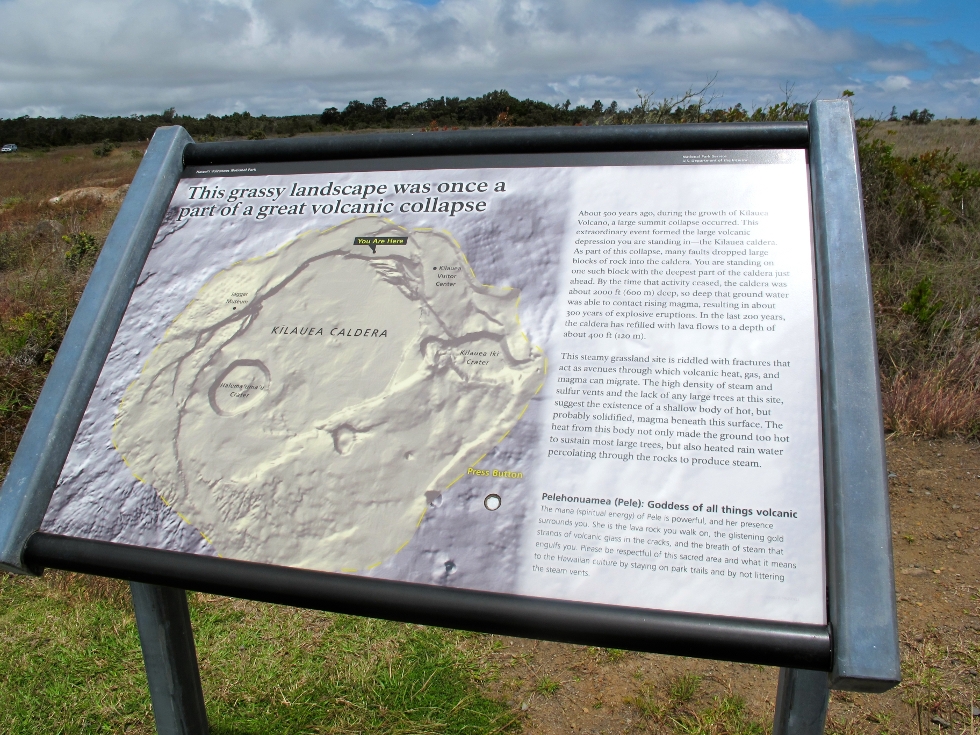A placard posted near the Wahinekapu (“sacred women”) Steam Vents at Hawaii Volcanoes National Park locates the visitor on a map (“You Are Here”) and frames the viewing experience in scientific vocabulary: “This grassy landscape was once a part of a great volcanic collapse. About 500 years ago, during the growth of the Kilauea Volcano, a large summit collapse occurred. . . .” Two paragraphs into this geological discourse, the subject seamlessly shifts to declare the landscape spiritual terrain. A boldface subtitle announces that “Pelehonuamea (Pele)” is “Goddess of all things volcanic”; the text continues: “The mana (spiritual energy) of Pele is powerful, and her presence surrounds you. She is the lava rock you walk on, the glistening gold strands of volcanic glass in the cracks, and the breath of steam that engulfs you.” The final line of text names the land as “sacred” and then gently invokes “Hawaiian culture” as interpretive context: “Please be respectful of this sacred area and what it means to the Hawaiian culture by staying on park trails and by not littering the steam vents.” A nearby placard asserts “a Hawaiian landscape . . . is often a site of great spiritual significance.”
These two signs incorporate within themselves the general peculiarities of National Park Service (NPS) informational signage at HVNP: the signs include multiple registers of experience and information and seem to address scientific, scholarly, reverential, and devout audiences. The text moves from one to the other with less than a glimmer of acknowledgment. The NPS, the format suggests, is simply providing “information.” Here the information is of a scientific, “spiritual,” and regulatory sort and the audiences are presumably tourists of both natural and spiritual phenomena as well as Native Hawaiians concerned about stewardship of a landscape they consider sacred.
A bit farther down the Crater Rim Drive, the Thomas A. Jaggar Museum, opened in 1987, occupies the site immediately next door to the U.S. Geological Survey’s Hawaiian Volcano Observatory, from which scientists study Hawaii’s volcanoes. The NPS website describes the work of the museum: “The Thomas A. Jaggar Museum is a museum on volcanology with displays of equipment used by scientists in the past to study the volcano, working seismographs, and an exhibit of clothing and gear from scientists who got a bit too close to lava.” Easily visible from the Jaggar’s outdoor viewing area, steam billows skyward from the active Halema’uma’u Crater in the larger Kilauea Caldera.

Official signage inside and outside the museum names the park’s acreage as the “land where the goddess dwells” and invites the visitor to “experience for yourself, the spirit with-in this awe inspiring wahi kapu” or “sacred landscape” of volcanic rock. One sentence acknowledges a cultural source for this interpretation but anticipates that contemporary visitors of any ethnicity or heritage will share a common response: “As you enter this wahi kapu, prepare to be inspired, for Native Hawaiians believe this to be the home of Pelehonuamea (Pele), the creator and creative energy that formed these volcanic islands.” The texts on these signs juxtapose multiple frames of reference within their own literal frames. Each placard carries the header “National Park Service/U.S. Department of the Interior” in its upper right-hand corner.
It is not the inclusion of information about ancient Hawaiian culture and religion that elicits my attention here—but rather the preference for the terms “spiritual” and “sacred,” the integration of the scientific and the spiritual, the NPS promotion of spiritual positioning and sensation within the visitor (“experience for yourself the spirit within….”; “prepare to be inspired”; “[Pele’s] presence surrounds you”), and the conflation of past and present moments in Hawaiian practice and “tradition” into one long, indistinguishable set of beliefs and behaviors. Science and spirituality become mutually reinforcing “truths.” The word “religion” is rarely if ever uttered. This is “spirituality.”It is “sacred,” it is Hawaiian culture—it is also natural.
Page 1 of 5 | Next page
